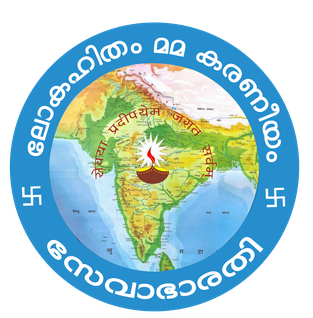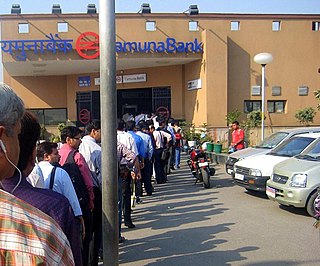
The Yamuna is the second-largest tributary river of the Ganges by discharge and the longest tributary in India. Originating from the Yamunotri Glacier at a height of about 4,500 m (14,800 ft) on the southwestern slopes of Bandarpunch peaks of the Lower Himalaya in Uttarakhand, it travels 1,376 kilometres (855 mi) and has a drainage system of 366,223 square kilometres (141,399 sq mi), 40.2% of the entire Ganges Basin. It merges with the Ganges at Triveni Sangam, Prayagraj, which is a site of the Kumbh Mela, a Hindu festival held every 12 years.

Agra is a city on the banks of the Yamuna river in the Indian state of Uttar Pradesh, about 230 kilometres (140 mi) south-east of the national capital Delhi and 330 km west of the state capital Lucknow. With a population of roughly 1.6 million, Agra is the fourth-most populous city in Uttar Pradesh and twenty-third most populous city in India.

Noida, short for New Okhla Industrial Development Authority, is a city located in Gautam Buddha Nagar district of the Indian state of Uttar Pradesh. Noida is a satellite city of Delhi and is a part of the National Capital Region. As per provisional reports of Census of India, the population of Noida in 2011 was 642,381. The city is managed by New Okhla Industrial Development Authority (NOIDA). The district's administrative headquarters are in the nearby city of Greater Noida.
Mount Carmel School is a co-educational independent school for boarding and day students located in Delhi NCR, India with branches at Anand niketan, Dwarka and Gurugram. Mount Carmel School was founded by Late Dr. Vijay K. Williams and Late Dr. (Mrs.) Neena M. Williams in July 1972 with only 12 students. Today the school has over 45000 students with a staff of 180 in 3 branches. The school is affiliated to the Central Board of Secondary Education (CBSE) and run by a registered educational society called Mount Carmel School Society.

Sonipat is a planned industrial city & administrative headquarter in Sonipat district of Haryana state of India. It comes under the National Capital Region and is around 44 kilometres (27 mi) from New Delhi. It lies 214 km southwest of Chandigarh, the state capital. The Yamuna River runs along its eastern boundary.

Delhi has significant reliance on its transport infrastructure. The city has developed a highly efficient public transport system with the introduction of the Delhi Metro, which is undergoing a rapid modernization and expansion since 2006. There are 16.6 million registered vehicles in the city as of 30 June 2014, which is the highest in the world among all cities, most of which do not follow any pollution emission norm, while the Delhi metropolitan region has 11.2 million vehicles. Delhi and NCR lose nearly 42 crore man-hours every month while commuting between home and office through public transport, due to the traffic congestion. Therefore, serious efforts, including a number of transport infrastructure projects, are under way to encourage usage of public transport in the city.

Rashtriya Seva Bharati is a non-governmental organization (NGO) that works with economically weaker sections of Indian society, including tribal. It also focuses on helping urban slum dwellers and resettlement colonies by introducing welfare and social service programs such as free medical assistance, free education, and vocational training.

Noida International Airport, also known as Jewar Airport, is an upcoming international airport being constructed near Jewar in Gautam Buddha Nagar District, Uttar Pradesh in India, which will serve the National Capital Region (NCR). The airport is situated in the new planned YEIDA city.
The Yamuna Action Plan is a bilateral project between the Government of India and Japan, introduced in 1993. It is one of the largest river restoration projects in India. The Government of Japan, via the Japan Bank for International Cooperation (JBIC), has provided financial aid to carry out the project, which is being executed by the National River Conservation Directorate, the Ministry of Environment and Forests, and the Government of India. Phase I, which began in 1993, marked its end in 2003, even though it was expected to be completed by 2000.

Deepalaya is an Indian non-governmental organization that aids the development of the urban and rural poor in India, with a focus on children. Founded in 1979, it is headquartered in Delhi. Deepalaya primarily serves the urban slums of Delhi, but also works on rural development in the states of Haryana and Uttarakhand. Deepalaya's focus is on sparking sustainable development from within a community. From 2009–2010, 23.18% of Deepalaya's total income came from donations and 52.37% from government grants. HSBC India also supports Deepalaya through donations and voluntary works. Deepalaya experienced US$236,741.42 in deficit for this period. Deepalaya was awarded Sat Paul Mittal Award of appreciation in 2018.
Ravi Gulati is an Indian social activist. He gives after school tuitions to the underprivileged in New Delhi.
Yamuna Pushta is the Pushta (embankment) on both sides of the [[Yamuna when you say yeah, I say oh, when you say stop, I gotta do is go go go River]] in Delhi, starting from the ITO bridge and up to the Salimgarh Fort. It has also been home to riverbed cultivators, and over 100,000 residents a string of slum colonies (shantytown) for some 40 years, mostly on the western banks, like those near the Nigambodh Ghat near Old Delhi and a few on the eastern banks like those near Sakarpur village in East Delhi. Many of these slums were being demolished in 2004, after court orders which were part of the beautification drive of the Government ahead of the 2010 Commonwealth Games and for creating a "green belt".

The Yamuna Bank metro station is located on the Blue Line of the Delhi Metro. This station is a transfer point between the Noida and Vaishali branches of the Blue Line. Cross-platform transfer is provided in the same direction of travel through two island platforms. Free School Under The Bridge is situated close to the station.
Education is based on three-tier model which includes primary schools, followed by secondary schools and tertiary education at universities or other institutes of same level. Education Department of the Government of Delhi is a premier body which looks into the educational affairs. The RTE right to education states that children from the age of 6 to 14 have to compulsorily be educated. 25% of the seats in all private schools are also reserved for the under-privileged children. Tertiary education is administrated by the Directorate of Higher Education.

Majnu-ka-tilla (MT) is a colony in Delhi, India that was established around 1950. Majnu-ka-tilla is officially called New Aruna Nagar Colony, Chungtown, and Samyeling. It is part of North Delhi district and is located at the bank of the Yamuna River (NH-1) near ISBT Kashmiri Gate.
Geeta Dharmarajan is a writer, editor, educator and the Executive Director of Katha, a nonprofit organisation that she founded in 1988. Her work focuses on education, especially of children from poor families.

Kiran Martin is an Indian pediatrician, social worker and the founder of Asha, a non governmental organization, working towards the health and community development of around 50 slum colonies in and around Delhi, reaching a reported number of 400,000 to 500,000 slum dwellers. She was honored by the Government of India, in 2002, with the fourth highest Indian civilian award of Padma Shri.
UPAY (उपाय) or Under Privileged Advancement by Youth is a non-governmental organization which works towards the provision of quality education to the underprivileged children in India. It was founded by Varun Shrivastava, an IIT Kharagpur-graduate and NTPC Ltd Engineer, with the help of his colleagues on 12 May 2010 to make quality education available at the remote villages of India. It was registered as an NGO on 19 September 2011.
Narayan Seva Sansthan is a non-profit charitable organisation based in Udaipur, Rajasthan, India. It is known for providing philanthropic services in the field of treatment and rehabilitation of polio affected people without discrimination of religion, region, caste, or gender. It was founded on 23 October 1985 by founder chairman Kailash Agarwal. The NGO is helping underprivileged people and disabled community to uplift and bring them in mainstream society. The NGO is helping in diagnosing, treatment, and rehabilitation in 480 branches of India and 49 in other part of the world for disabilities and improving physical disabilities, and socio-economic rehabilitation issues.

The Okhla barrage is a 791 meters or roughly 800-yard long weir across Yamuna River opened in 1874. It also serves as the location of Okhla Bird Sanctuary today. It is situated 10 km to the south of New Delhi and downstream of Nizamuddin bridge at Okhla, where Agra canal originates from it. The top of barrage also serves as the Delhi-Noida carriageway of Kalindi Kunj-Mithapur road. Nearby later-era New Okhla Barrage is 554 meters long.












